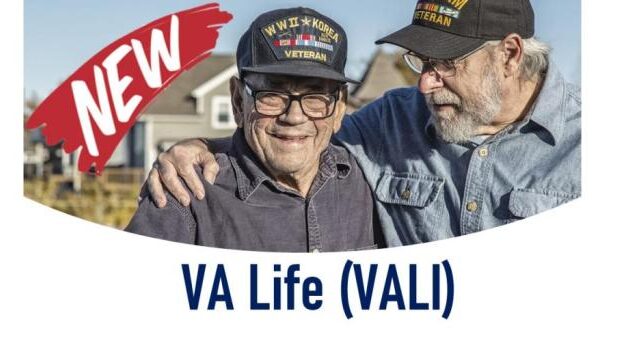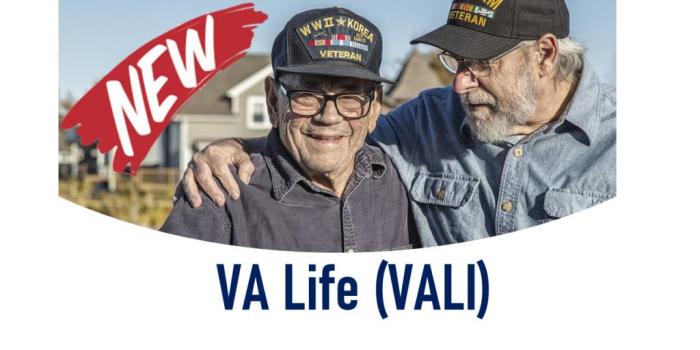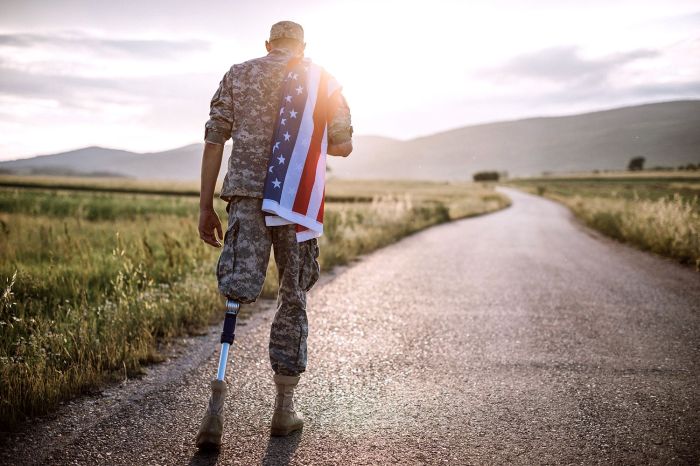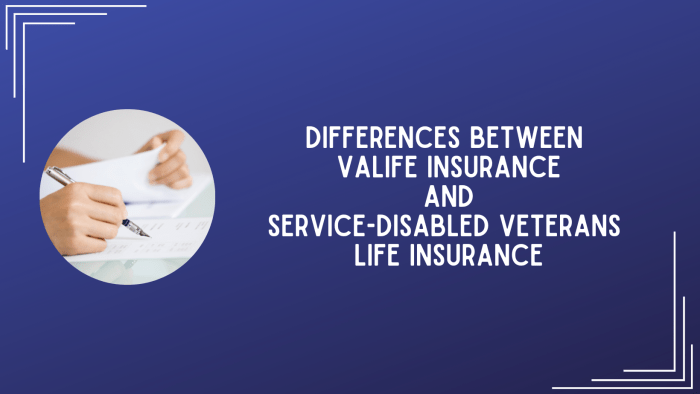
Transitioning from military service to civilian life presents numerous challenges, and securing your family’s financial future is paramount. Veteran life insurance plays a crucial role in this transition, offering vital protection and peace of mind. This guide delves into the various types of veteran life insurance available, helping you navigate the options and make informed decisions that best suit your individual needs and circumstances.
Understanding the nuances of Servicemembers’ Group Life Insurance (SGLI), Veterans’ Group Life Insurance (VGLI), and private life insurance options is key to effectively planning for the future. We’ll explore eligibility requirements, application processes, cost structures, and the benefits each type offers, equipping you with the knowledge to choose the most appropriate coverage for your family.
Types of Veteran Life Insurance
Securing your family’s financial future is a top priority, and for veterans, several life insurance options exist to provide that crucial safety net. Understanding the differences between these options is key to choosing the best fit for your individual circumstances and financial goals. This section will explore the key types of life insurance available to veterans, comparing their features, benefits, and costs.
Servicemembers’ Group Life Insurance (SGLI)
SGLI is a term life insurance policy offered to active-duty members of the uniformed services, including the Army, Navy, Air Force, Marine Corps, Coast Guard, and certain reserve components. It provides affordable coverage, typically in increments of $100,000, up to a maximum amount. Premiums are deducted directly from the service member’s pay. A significant advantage of SGLI is its portability. Under certain conditions, service members can convert their SGLI coverage to Veterans’ Group Life Insurance (VGLI) upon leaving active duty. This allows for continued coverage without undergoing a medical examination.
Veterans’ Group Life Insurance (VGLI)
VGLI is a term life insurance policy available to veterans who had SGLI coverage while on active duty. It’s essentially a continuation of SGLI coverage, but with a slightly different premium structure and some variations in coverage options depending on the date of conversion. The key benefit is the ability to maintain relatively inexpensive life insurance coverage without having to undergo a medical exam, unlike many private life insurance policies. The coverage amount and premium will vary based on the amount of SGLI coverage converted and the veteran’s age at the time of conversion. The policy is renewable, but premiums increase with age.
Private Life Insurance Options
Veterans also have access to private life insurance options from commercial insurers. These policies offer a broader range of choices, including term life insurance (coverage for a specific period), whole life insurance (permanent coverage with a cash value component), and universal life insurance (flexible premiums and death benefits). While these policies may offer higher coverage amounts and more flexible features than SGLI or VGLI, they typically require a medical examination and the premiums are generally higher. The cost will depend on factors such as the applicant’s age, health, and the amount of coverage desired. However, the flexibility and potential for higher coverage amounts often make private options attractive to veterans with significant financial responsibilities.
| Policy Type | Cost Structure | Coverage Amounts | Eligibility Requirements |
|---|---|---|---|
| SGLI | Premiums deducted from military pay; relatively low cost | $100,000 increments, up to a maximum amount | Active-duty uniformed service members |
| VGLI | Premiums increase with age; generally low cost compared to private options | Varies based on SGLI coverage at separation | Veterans with prior SGLI coverage |
| Private Term Life Insurance | Premiums vary based on age, health, and coverage amount; generally higher than SGLI/VGLI | Wide range of coverage amounts available | Generally available to anyone who meets the insurer’s underwriting requirements |
Eligibility and Application Process
Securing veteran life insurance requires understanding the eligibility criteria and navigating the application process. Each type of veteran life insurance has specific requirements, and fulfilling them is crucial for successful application. This section details the eligibility requirements and application procedures for various veteran life insurance options, including the process of converting Servicemembers’ Group Life Insurance (SGLI) to Veterans’ Group Life Insurance (VGLI).
Eligibility for Servicemembers’ Group Life Insurance (SGLI)
Eligibility for SGLI is primarily determined by active military service. Generally, all members of the uniformed services on active duty are eligible for SGLI coverage. This includes active-duty members of the Army, Navy, Air Force, Marine Corps, Coast Guard, and certain members of the Reserves and National Guard while on active duty. There are no specific health condition limitations for initial SGLI enrollment. Age limitations are typically tied to the maximum age for active service in the respective branch of the military.
Eligibility for Veterans’ Group Life Insurance (VGLI)
VGLI eligibility hinges on prior SGLI coverage. Veterans must have had SGLI coverage while on active duty to be eligible for VGLI conversion. The application for VGLI must be made within a specified timeframe after leaving active duty. There may be health condition considerations during the conversion process, and the insurer may require a medical exam depending on the amount of coverage sought and the applicant’s age. Age limits for VGLI coverage vary depending on the plan selected and the insurer.
Application Process for SGLI
Applying for SGLI is typically a straightforward process handled through the service member’s military personnel office. Required documentation generally includes the service member’s military identification and potentially a completed application form. The application process often involves completing an electronic form and confirming the desired coverage amount.
Application Process for VGLI
The VGLI application process involves several key steps. First, the veteran must apply for VGLI conversion within a designated timeframe after leaving active duty, usually within a year or 120 days. This often involves completing a form from the Department of Veterans Affairs (VA) and providing documentation such as a copy of their DD-214 (Certificate of Release or Discharge from Active Duty) and proof of SGLI coverage. The veteran then selects the desired coverage level, and depending on factors such as age and health, the insurer may require a medical examination. The application is then processed, and upon approval, the veteran’s VGLI coverage commences.
Step-by-Step Guide: VGLI Conversion
- Determine Eligibility: Verify eligibility based on prior SGLI coverage and the applicable timeframe for conversion.
- Gather Required Documents: Collect necessary documents, including DD-214, proof of SGLI coverage, and potentially other supporting documentation.
- Complete the Application: Fill out the VGLI application form accurately and completely.
- Submit the Application: Submit the completed application and supporting documents to the designated agency or insurer.
- Undergo Medical Examination (if required): If requested, undergo a medical examination as part of the underwriting process.
- Receive Confirmation: Await confirmation of approval or denial of the VGLI application.
- Begin Coverage: Upon approval, the VGLI coverage will commence.
Cost and Premiums

Understanding the cost of veteran life insurance is crucial for making an informed decision. Several factors interact to determine your premium, making it essential to carefully consider your individual circumstances. This section will explore these factors and provide examples to help you better understand the pricing structure.
Several key factors influence the cost of your veteran life insurance premiums. Your age is a significant determinant, as older individuals generally face higher premiums due to increased risk. Your health status also plays a critical role; applicants with pre-existing conditions or health concerns may see higher premiums or even be denied coverage altogether. The amount of coverage you choose directly impacts the cost; a larger death benefit means higher premiums. Finally, the type of policy you select – term life insurance, whole life insurance, or other variations – will also affect the premium amount. Term life insurance, for instance, usually offers lower premiums than whole life insurance due to its limited coverage period.
Premium Cost Examples
The following table provides estimated premium costs for different policy types and coverage amounts. Remember that these are estimates only, and your actual premium will depend on your specific circumstances. It’s crucial to obtain personalized quotes from multiple insurers for accurate pricing.
| Policy Type | Age | Coverage Amount | Estimated Premium (Annual) |
|---|---|---|---|
| Term Life (10-year) | 35 | $250,000 | $300 |
| Term Life (20-year) | 45 | $500,000 | $700 |
| Whole Life | 30 | $100,000 | $1,200 |
| Whole Life | 50 | $250,000 | $2,500 |
Finding Affordable Options
Securing the most affordable veteran life insurance requires careful comparison shopping. Start by obtaining quotes from multiple insurers, emphasizing your veteran status to see if you qualify for any special rates or discounts. Consider your needs carefully; a shorter term policy might be more affordable if you only need coverage for a specific period. Maintaining a healthy lifestyle can also help lower your premiums. Finally, exploring options like group life insurance through veteran organizations might offer lower rates than individual policies.
Benefits and Coverage

Veteran life insurance policies offer a range of benefits designed to provide financial security for surviving family members after the death of a veteran. The specific benefits and coverage amounts vary depending on the type of policy chosen and the individual’s circumstances. Understanding these options is crucial for making an informed decision about the right level of protection.
The primary benefit of veteran life insurance is the death benefit, a lump-sum payment made to the designated beneficiary upon the death of the insured veteran. This payment can be used to cover a wide array of expenses, including funeral costs, outstanding debts, mortgage payments, and ongoing living expenses for the surviving spouse and children. The amount of the death benefit is determined at the time the policy is purchased and remains fixed unless the policyholder makes changes.
Death Benefit Payment Options
Many veteran life insurance policies offer flexibility in how the death benefit is paid out. Beneficiaries may receive the full amount as a lump sum, or they may choose to receive payments over a period of time, such as through an annuity. This structured payout can provide a more stable income stream for the surviving family, ensuring financial stability for the long term. The specific options available depend on the policy terms.
Circumstances Where Veteran Life Insurance is Most Beneficial
Veteran life insurance is particularly beneficial in situations where the veteran is the primary breadwinner for their family. If the veteran’s death would create a significant financial hardship for their dependents, life insurance can help mitigate this risk. This is especially true for families with young children or those with significant debts, such as a mortgage or outstanding student loans. For example, a veteran with a young family and a substantial mortgage would find significant comfort in knowing their family’s financial future is secure in the event of their passing.
Illustrative Example of Death Benefit Usage
Consider a veteran with a $300,000 life insurance policy who passes away unexpectedly. Their surviving spouse could use this death benefit to pay off their $200,000 mortgage, cover funeral expenses of approximately $15,000, and have remaining funds to support their children’s education and daily living expenses. Without the life insurance payout, the family might face severe financial difficulties, including potential foreclosure or the need to significantly alter their lifestyle.
Additional Coverage Options
Some veteran life insurance policies may offer additional coverage options, such as accidental death benefits or terminal illness benefits. Accidental death benefits provide an additional payout if the death results from an accident, while terminal illness benefits offer a portion of the death benefit to help cover expenses associated with a terminal illness. These supplemental benefits provide an extra layer of financial protection in specific circumstances.
Comparing Veteran Life Insurance with Private Options

Choosing the right life insurance policy is a crucial decision for veterans, especially considering the unique benefits and challenges they face. This section compares and contrasts veteran-specific life insurance with private options, highlighting factors to consider when making this important choice. Understanding the nuances of each type can lead to a more informed and suitable decision for your individual needs and circumstances.
Veterans often have access to both Servicemember’s Group Life Insurance (SGLI) and Veterans’ Group Life Insurance (VGLI), which are government-backed options. However, private life insurance companies also offer a wide array of policies. Each type presents distinct advantages and disadvantages depending on a veteran’s specific circumstances, health, and financial goals.
Factors Influencing the Choice Between Veteran and Private Life Insurance
Several key factors influence the decision-making process when choosing between veteran-specific and private life insurance. These factors are interconnected and should be carefully weighed against individual needs and long-term financial planning. Failing to consider these aspects could lead to a suboptimal choice.
Veterans should consider their health status, age, financial situation, desired coverage amount, and the length of coverage needed. The availability of specific riders or benefits, such as those addressing terminal illness or long-term care, also play a significant role. Furthermore, the premiums and the overall cost of each policy type should be compared to determine affordability and long-term financial viability.
Comparison of Key Features: Veteran vs. Private Life Insurance
The following table provides a direct comparison of key features between veteran-specific life insurance and private life insurance options.
| Feature | Veteran Insurance (e.g., VGLI) | Private Insurance | Advantages/Disadvantages |
|---|---|---|---|
| Eligibility | Generally available to veterans who served on active duty, subject to specific service requirements and timeframes. | Open to most individuals, regardless of military service, subject to underwriting and health assessments. | Advantage: Easier access for eligible veterans. Disadvantage: Limited eligibility criteria for veterans. Advantage: Wider accessibility for those ineligible for veteran insurance. Disadvantage: More stringent underwriting processes. |
| Premiums | Generally lower premiums due to group rates and government subsidies. | Premiums vary widely based on age, health, coverage amount, and policy type. | Advantage: Lower cost for eligible veterans. Disadvantage: Limited flexibility in coverage amounts and policy types. Advantage: Greater flexibility in coverage and policy choices. Disadvantage: Potentially higher premiums. |
| Coverage Amounts | Typically offers standardized coverage amounts, often with limitations. | Offers a wider range of coverage amounts to suit individual needs and financial goals. | Advantage: Simple and straightforward coverage. Disadvantage: May not meet the needs of individuals requiring higher coverage amounts. Advantage: Tailored coverage to individual needs. Disadvantage: Higher premiums for higher coverage amounts. |
| Underwriting | Often less stringent underwriting requirements than private insurance. | Underwriting involves a thorough health assessment and risk assessment. | Advantage: Easier qualification for many veterans. Disadvantage: Less flexibility in policy customization. Advantage: Ability to tailor coverage to specific needs. Disadvantage: More rigorous application process. |
| Policy Types | Typically offers term life insurance, sometimes with options for conversion to permanent insurance. | Offers a wide variety of policy types, including term life, whole life, universal life, and variable life insurance. | Advantage: Simplicity and straightforwardness. Disadvantage: Limited policy options. Advantage: Variety of policies to match diverse needs. Disadvantage: Increased complexity in choosing a policy. |
Final Conclusion
Planning for the future is a crucial aspect of veteran life, and securing adequate life insurance coverage is a significant step in ensuring the financial well-being of your loved ones. By understanding the diverse options available, from SGLI and VGLI to private policies, and carefully considering your individual circumstances, you can make informed decisions that provide lasting security and peace of mind. This guide serves as a starting point; consulting with a financial advisor is recommended for personalized guidance.
FAQ Section
Can I convert my SGLI to VGLI if I have a pre-existing health condition?
Yes, you can usually convert your SGLI to VGLI even with pre-existing conditions, but your premiums may be higher depending on the severity of the condition. You will need to complete a health questionnaire as part of the application process.
What happens to my VGLI if I change jobs?
Your VGLI coverage remains in effect regardless of your employment status. It is a permanent policy, unlike SGLI, which is tied to active military service.
Is there an age limit for applying for VGLI?
There is no age limit to apply for VGLI as long as you convert your SGLI policy within a specific timeframe after leaving active duty. However, premiums will increase with age.
How long does the VGLI application process take?
The processing time varies, but generally, it takes several weeks. It’s best to start the application as soon as possible after leaving active duty.
Нотатки https://notatky.net.ua пізнавальний блог. Історія, особистості, наша планета, наука та наукові терміни простими словами